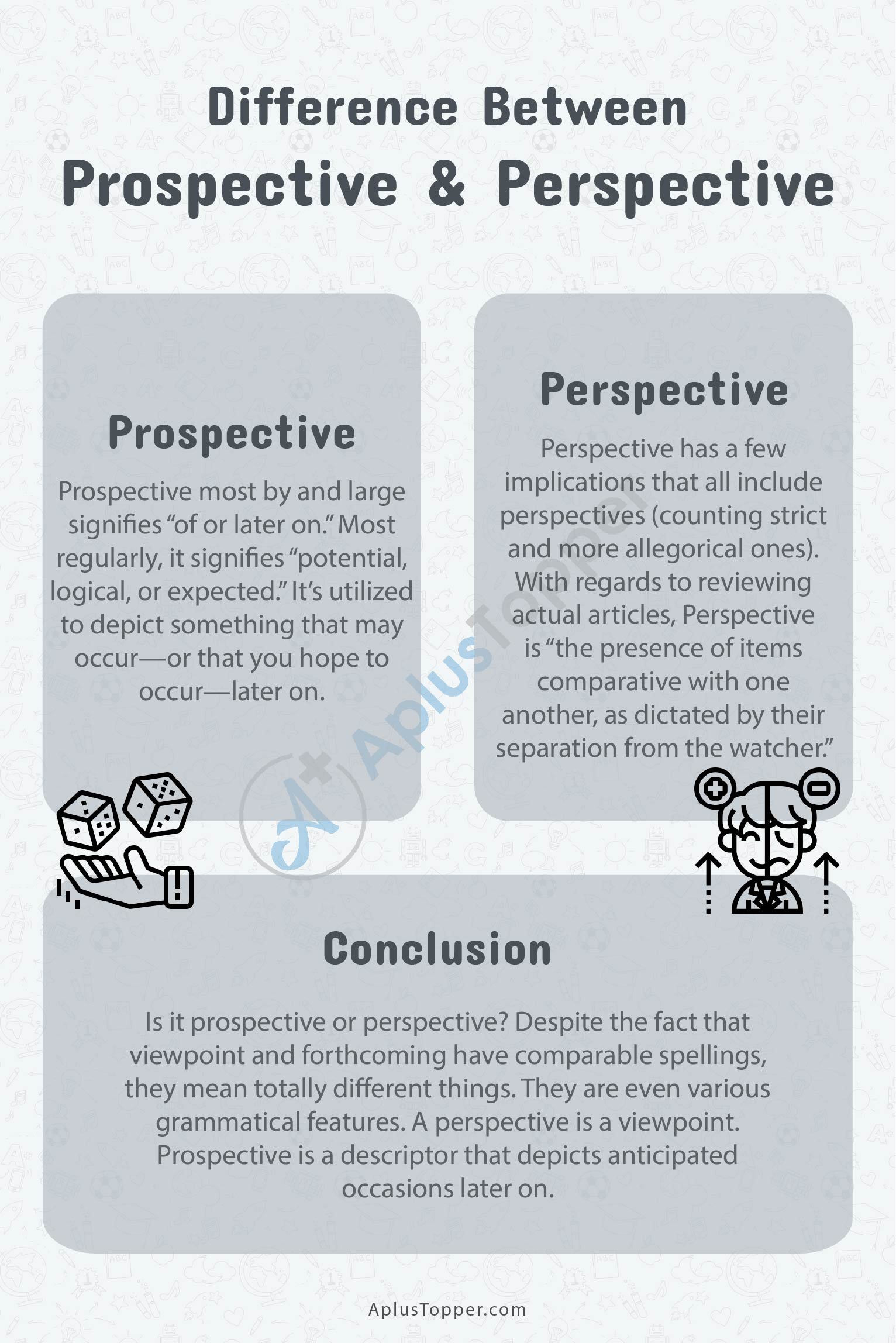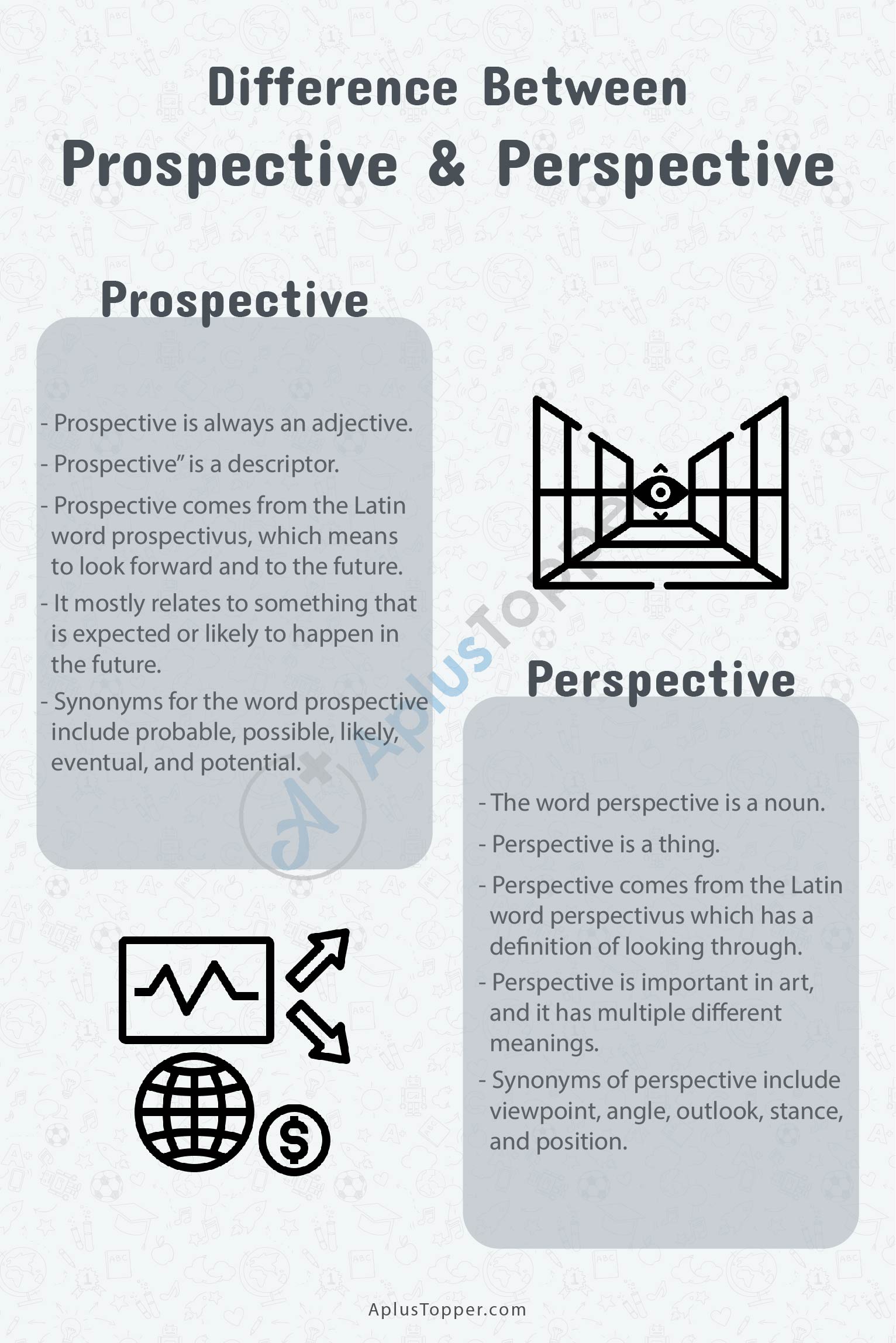Prospective vs Perspective: Prospective is utilized with regards to looking forward to what in particular may occur later on. Perspective is utilized with regards to perspectives or the situation from which something is seen.
The distinction can be befuddling, particularly since they sound so much indistinguishable. We’ll separate the distinction in importance, examine a portion of the normal manners by which each word is utilized, and give some Perspective on these Prospective augmentations to your jargon!
Prospective has to do with what may occur later on—it implies potential, possible, or expected, as in planned understudies or Prospective Clients. Perspective identifies with perspective—it can allude to an actual perspective, an individual perspective, or a strategy utilized in craftsmanship.
Definition of Prospective
Prospective most by and large signifies “of or later on.” Most regularly, it signifies “potential, logical, or expected.” It’s utilized to depict something that may occur—or that you hope to occur—later on.
Schools attempt to select planned understudies to join in. Planned customers are expected customers—those you need to become customers. Imminent profit is income you haven’t acquired at this point yet desire to.
The more broad feeling of the word is utilized to depict things that identify with what’s to come. A Prospective perspective is one that looks toward the future and what might occur. Yet, don’t mistake that for point of view.
Definition of Perspective
Perspective has a few implications that all include perspectives (counting strict and more allegorical ones).
With regards to reviewing actual articles, Perspective is “the presence of items comparative with one another, as dictated by their separation from the watcher.” A structure looks significantly greater when you’re remaining close to it than it does well in advance. That distinction is because of Perspective.
This standard is applied in visual craftsmanship. Craftsmen utilize point of view to make objects in two-dimensional fine art seem three-dimensional (by recommending profundity or distance).
All the more, by and large, Perspective alludes to the situation from which something is seen, as I might suspect we’ll improve Perspective from the rooftop. This feeling of the word can likewise be utilized with regards to workmanship to allude to the situation from which the subject of craftsmanship has been portrayed—from beneath or from a 10,000-foot perspective, for instance.
It can likewise be utilized in an allegorical manner to allude to an individual’s perspective, particularly one dependent on their insight, experience, and foundation, as in I’d prefer to hear Jane’s Perspective on the matter.
Once in a while, the word Perspective is utilized to mean with regards to exactly the same thing as objectivity—the legitimate or precise perspective or the capacity to see it, as in Hopefully this new data will give you some point of view. This is the thing that individuals mean when they advise you to place a circumstance in context.

How to Use Prospective?
The descriptor prospective is future situated. It implies likely or expected to occur or become later on—so, a logical result. The word comes from prospectivus, a Latin expression significance to look toward what’s to come.
“Prospective” can be viewed as an extraordinary equivalent for “potential”. It is consistently a descriptive word and it is utilized to depict something that has not yet occurred, however, is conceivable, expected and liable to occur later on. Normally, this descriptive word is put before things, for example, “representatives”, “bosses”, “purchasers”, “venders”, “guardians”, “accomplices” and so on.
How to Use Perspective?
From an overall view, the thing perspective alludes to a mentality, a standpoint, a bunch of standards, a perspective, or a unique situation. In drawing, painting, and photography, notwithstanding, it alludes to a method of depicting (1) three-dimensional spatial connections on a two-dimensional surface, (2) the point from which something is seen, and (3) the legitimate appearance of items corresponding to one another.
“Perspective” is utilized as a thing, characterizing a method of seeing things, one sort of view/approach upon a matter, a circumstance or an article, the way one ponders something. Simultaneously, it can allude to a point from where an item can be found in a specific position so it appears to be practical.

Difference between Prospective and Perspective
As a matter of first importance, the significant contrast between this pair of words is addressed by their syntactic capacities. “Perspective” is a thing, though “prospective” is a descriptor. There is no situation where these words assume one more part or are utilized as an alternate grammatical form, so this is the first fundamental motivation behind why they ought to never be frustrated and utilized rather than the other.
Also, we should speak a little with regard to their lexical implications. “Perspective” characterizes an idea, a viewpoint, while “prospective” portrays something that may occur, something conceivable yet unsure. Thusly, don’t let yourself be deceived by the comparative spellings of “perspective” and “prospective”. They are various words, an extraordinary illustration of paronyms, which have totally various implications and can no chance be viewed as equivalents.
Conclusion on Prospective vs Perspective
Is it prospective or perspective? Despite the fact that viewpoint and forthcoming have comparable spellings, they mean totally different things. They are even various grammatical features. A perspective is a viewpoint. Prospective is a descriptor that depicts anticipated occasions later on.
A simple way of keeping these words straight in your mind is to recall that a miner looks for gold that he hopes to find later on. A miner can be supposed to be a prospective locater of gold. By remembering this stunt, you can generally make certain to utilize perspective and plan effectively in your composition. For a speedy supplemental class, you can allude back to this article too.
FAQ’s on Prospective vs Perspective
Question 1.
What is the difference between perspective and prospective?
Answer:
The difference between perspective and prospective is all by the way you check out it. Prospective is utilized with regards to looking forward to what in particular may occur later on. Perspective is utilized with regards to viewpoints or the situation from which something is seen.
Question 2.
What is an example of prospective?
Answer:
The example is “We need to check on prospective employers in the company”.
Question 3.
What is an example of perspective?
Answer:
The example is “My perspective for this theory is different”.
Question 4.
Are perception and perspective the same?
Answer:
Perception is your insight into a thing or a situation. Perspective is your viewpoint.
